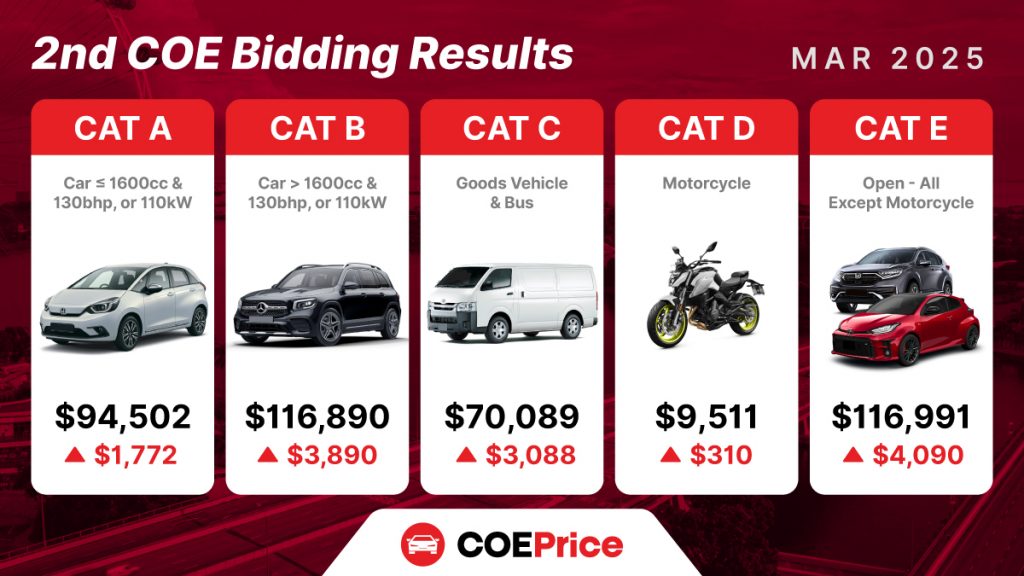The latest COE bidding session for March 2025 has delivered notable shifts across all categories. With quota premiums rising and adjustments in both quota allocation and bid numbers, the data clearly reflects a competitive market with evolving buyer sentiment. Here’s a detailed breakdown based solely on the March results:
Table of Contents
Overview of the March 2025 2nd COE Bidding Session
The March session saw upward adjustments in quota premiums across all COE categories. Despite the increased premiums, the numbers for quotas and bids indicate differing degrees of buyer activity across the segments. These trends offer insights into market dynamics as buyers adapt to a tighter supply environment.
Category-by-Category Analysis
CAT A: Small Cars
(Cars ≤ 1600cc & 130bhp, or 110kW)
- Quota Premium: Increased to $94,502, up by $1,772 compared to previous sessions.
- PQP: Recorded at $92,525 in March.
- Quota & Bids: The quota figure dropped slightly by 6 units (now 1,138) and bids decreased by 83 (totaling 1,951).
Analysis: Although the premium is higher, the modest decline in both quota and bid numbers suggests that buyers remain cautious in a market where the cost of entry is rising.
CAT B: Larger Cars
(Cars > 1600cc or 130bhp, or 110kW)
- Quota Premium: Now at $116,890, showing an increase of $3,890.
- PQP: Recorded at $111,807 in March.
- Quota & Bids: A slight reduction was seen with the quota decreasing by 18 units (to 747) and bids down by 12 (totaling 1,196).
Analysis: The increased premium and PQP indicate a tightening market for larger cars. The minor drop in both quota and bid figures reflects buyer hesitation in response to steeper price increments.
CAT C: Goods Vehicle & Bus
- Quota Premium: Settled at $70,089, an increase of $3,088.
- PQP: Recorded at $66,874 in March.
- Quota & Bids: Contrary to the previous categories, quotas rose by 15 (now 277) and bids increased by 56 (totaling 469).
Analysis: The uptick in both quotas and bids suggests that the goods vehicle and bus segment remains attractive, possibly due to relatively more favorable pricing dynamics in this category.
CAT D: Motorcycle
- Quota Premium: Increased to $9,511, marking a rise of $310.
- PQP: Recorded at $8,344 in March.
- Quota & Bids: Both metrics showed slight increases with quota up by 6 (to 525) and bids rising by 2 (totaling 626).
Analysis: The motorcycle segment remains stable, with modest growth across key indicators hinting at sustained buyer confidence in this more affordable option.
CAT E: Open Category
(All Except Motorcycle)
- Quota Premium: Recorded the highest premium at $116,991, with an increase of $4,090.
- PQP: Data not available.
- Quota & Bids: Both numbers declined, with quota down by 4 (to 198) and bids dropping by 21 (totaling 382).
Analysis: The steep premium in the open category appears to have deterred some bidders, leading to a decrease in both quota uptake and bid volume. This suggests that buyers in this segment may be reassessing their bidding strategies due to the higher costs.
Market Implications
The March 2025 2nd COE bidding session clearly shows a market under pressure from rising premiums amid a constrained supply. While all categories experienced premium hikes, the varying changes in quota and bid numbers reveal distinct buyer responses:
- Categories A, B, and E indicate a more cautious approach among buyers, likely driven by the increased financial burden.
- Categories C and D demonstrate relatively buoyant performance, suggesting these segments are more resilient in the current market.
For buyers and industry analysts alike, these trends signal the need for adaptive strategies in future bidding sessions. The current figures underscore the importance of closely monitoring market shifts as the government and industry stakeholders navigate the challenges of a tightening vehicle registration landscape.
Conclusion
In summary, the latest March 2025 results reflect an active yet cautious COE market. Rising premiums across the board, combined with nuanced shifts in quotas and bid numbers, illustrate a competitive environment where buyers must balance cost considerations against market demand. As the sector adapts to these changes, both policymakers and market participants will need to stay vigilant to maintain a balanced and dynamic COE landscape.

